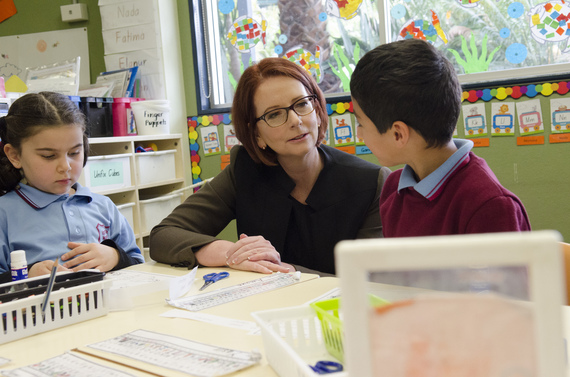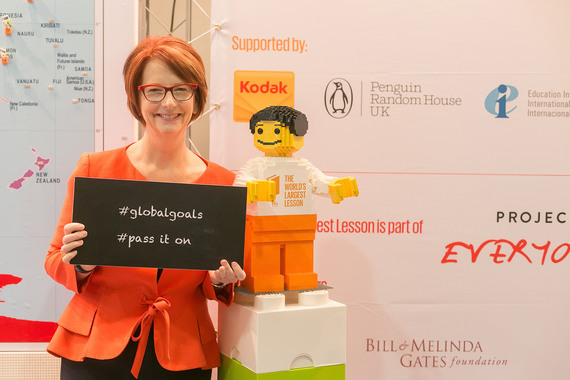As the UN prepares to host the General Assembly and the Global Goals for Sustainable Development Summit, I talk to Julia Gillard, former Prime Minister of Australia and Chair of the Global Partnership for Education about the Goals, the role of technology in education and how collective collaboration can ensure education is available for every child across the world.
The UN has just announced its sustainable development goals. How realistic do you think the timeframe for reaching them is?
The sustainable development goals are ambitious and audacious - as they have to be. When you consider that 124 million children of primary and lower-secondary school age are not in school around the globe, we have to be ambitious. When you consider that hundreds of millions of children either do not make it to grade 4 or reach it without basic reading, writing and math skills, we have to be audacious. The new education goal calls for "inclusive and equitable quality education and the promotion of lifelong learning opportunities for all." But to fulfill these noble words we need a commitment of sufficient resources.
UNESCO estimates that there is an annual external financing gap of US$39 billion to provide quality pre-primary, primary and secondary education to all children by 2030. That's what we need to address - urgently.
The new Financing Commission announced by the Norwegian government and to be chaired by Gordon Brown will provide leadership to rally the international community around filling that gap. The Commission will go a long way to invigorate global education financing and identify more effective and better coordinated ways to deploy resources ensuring that children have access to school and learn.
How are you and the Global Partnership for Education targeting philanthropists to support and back UNESCO's ambitious goal of targeting the annual $39 billion funding gap?
One of the Global Partnership for Education's primary roles is to raise awareness and mobilize action and funding by all our partners, including a growing number of philanthropies, around the urgency of the education challenge many countries face. Traditional donors alone will not fill the $39 billion gap, so we are calling on key actors, including the emerging nations which are moving to be aid donors, the private sector and private philanthropy to step up and contribute.
How do you think finance for education could be raised in a revolutionary way?
We see a critical need in education for innovative financing solutions of the kind that have been a game changer for the health sector and enabled it to function at a large scale over the past decade.
In addition there is a need for seed financing to help create new ways of working in education. Once we see something works, after due diligence, we can scale up. I am thinking of new ways of providing books, technology, teacher and professional support materials and student learning assessment mechanisms at scale.Then we can bring in the efficiencies that come with economies of scale.
What specific support do developing and conflict-effected nations require to play their part in achieving the sustainable development goals?
The Global Partnership for Education works with 60 developing countries and fully half of our work is with fragile and conflict effected places. Our funding criteria are based on poverty, education vulnerability and fragility. Like our own nations, developing countries need approaches that are sustainable, support an overall system and fit all the various inputs together into a coherent strategy that will provide children with the ability to learn. Helping build that integrated, effective, long-term system is the mission of the Global Partnership.
At the same time, we require that they increase their own education budgets, ensure that their governance systems work and spend their own and external funding effectively. In circumstances of crisis we have been able to make funding available in as little as eight weeks. But to help bring education to the children who have been displaced in so many countries in recent years much more needs to be done. There is, thanks to Gordon Brown, an emerging consensus about the need to better meet the needs of the tens of millions of children at risk of losing their right to education.
In which areas do you think investment should be placed to have the biggest impact?
Equity is the magic word we need to focus on during the next decade and a half. There has been great progress over the past 15 years in reducing the number of out of school children from almost 200 million to 124 million today. But many of the children who are still out of school are not surprisingly, the hardest to reach. We have to work vigorously and creatively to get them in school. We need to ensure that every single child can fulfill his or her right to a quality education - irrespective of gender, ethnicity or religion; whether they live in rural or urban areas; belong to a disadvantaged group or have disabilities. This also includes children in fragile or conflict-affected countries. Every child deserves a quality education.
How is technology galvanizing the push towards the sustainable development goals?
Technology will have an enormously positive impact on education progress in developing countries. Teacher training, curriculum development, data management systems and knowledge exchange can all benefit from technological innovations. But technology only provides tools. It is important for countries first to have an education sector plan in place that outlines the long-term vision, goals and priority areas and then explains how to get there. Technology is also an area where the private sector can come in to assist.
From the individual to the NGO, the multi-national corporation to government, how can we collectively and constructively collaborate to ensure education is available for every child worldwide?
The Global Partnership for Education - which is a unique entity- is in a very strong position to unlock the full power of our partnership with civil society organizations, teacher organizations, bilateral and multilateral donors, the private sector and foundations to support developing country governments. My message for all who care about these issues and want to do something, is to speak out - through social media, through involvement in civil society organizations and through engagement with country leaders - to make educating the world's children one of the most urgent issues on the global development agenda.
This is what we will do under the umbrella of the Global Citizen Festival organized by the Global Poverty Project in Central Park in New York on September 26. Collectively, our voices joined together will do more to raise the volume that leads to real and constructive action.
How is your work at the Global Partnership for Education pushing countries and world leaders towards increasing global aid and supporting education for those who require it?
The post-2015 development agenda promotes partnership, country leadership and ownership, and effective development cooperation. It also asks donor countries to better align their aid with national systems in developing countries so that these countries can strengthen their capacities.
The business model of the Global Partnership, developed over the past decade, is designed around these very principles, and is putting them into practice in nations around the world. That's a compelling and convincing concept that is supported by both developing and donor countries as well as NGOs. Given the tight financial situation most economies are currently facing, and the needs I have described, we are determined to get make even more of a difference in the future.
As a converging force for quality education and lifelong learning, what are the Global Partnership for Education's plans going forward to meet these goals on an international scale?
The Global Partnership for Education is the most effective platform to leverage financing, technical expertise and advocacy to help strengthen education systems over time and at a scale that will make a difference. We are determined to fulfill our mission and grow our capacity and capability. We are currently working on a new strategic plan for 2016 to 2020 specifically designed to help us achieve the new sustainable development goal for education. We are ready to take on these big challenges - and succeed.
Julia Gillard, former Prime Minister of Australia, is Chair of the Board of Directors of the Global Partnership for Education, the only global multilateral partnership devoted to getting all children in school and learning.


